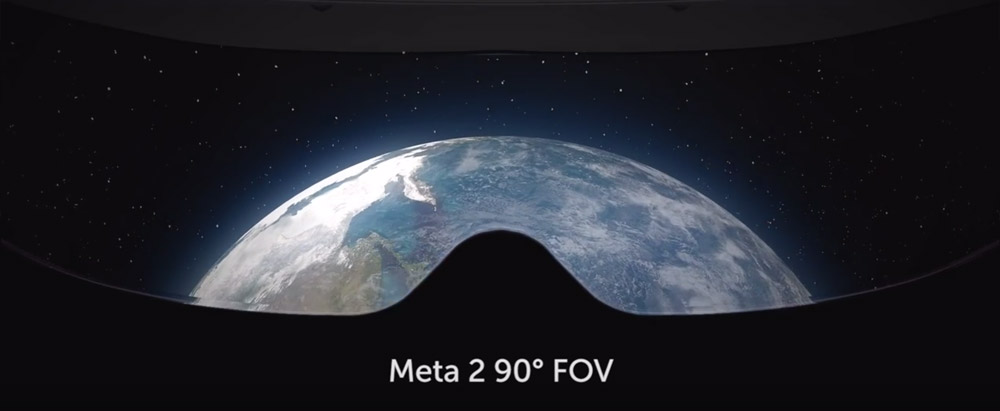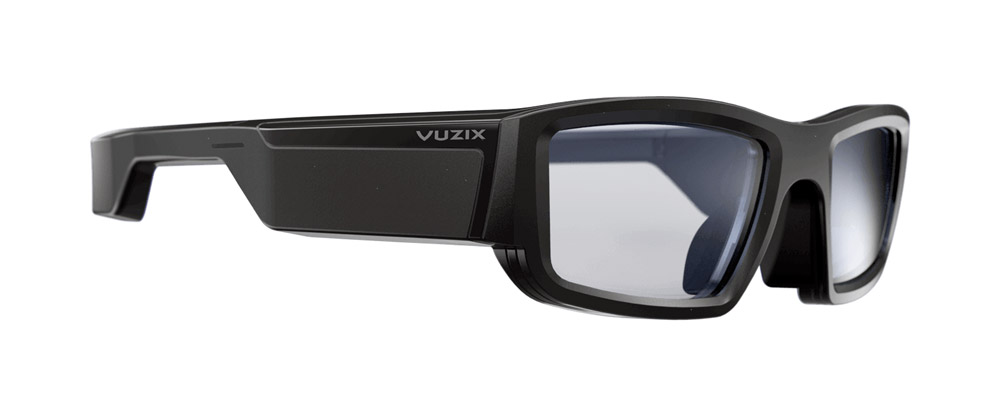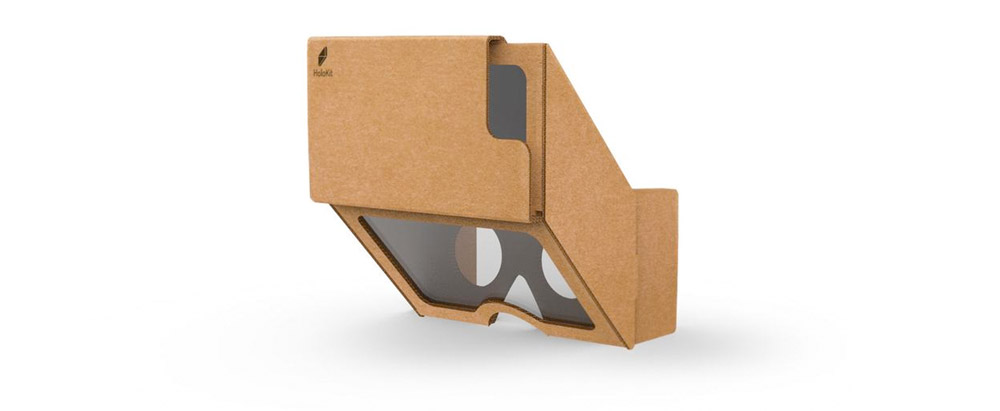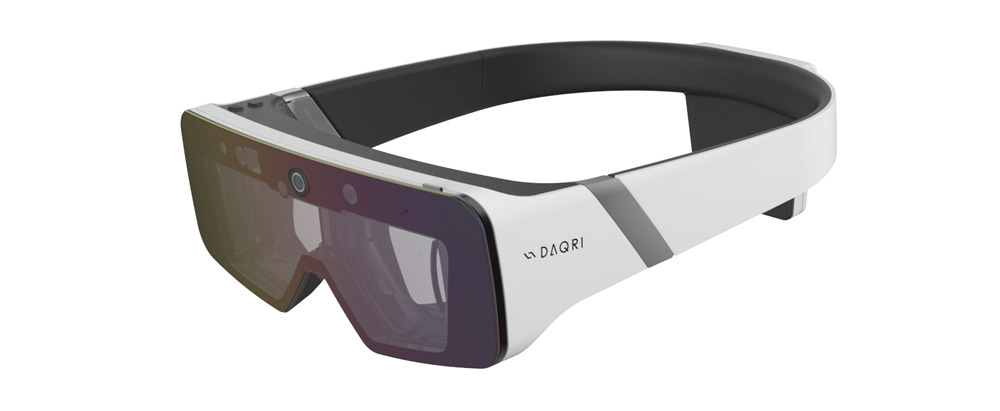15 AR headsets you need to know about in 2018
2018 is the year where augmented reality headset development really seems to be heating up! There are way more AR headsets looming around in 2018 than people realise — and not all of them are crazy expensive. Here’s a look at the headsets that have me excited about the industry’s potential right now.

It’s hard to imagine there are more than 15 AR headsets out there!
1. Meta 2

The Meta 2 Developer Kit (source: Meta)
The Meta 2 is the option among these which I’m the most enthusiastic about for two main reasons — field of view and their Workspace concept!
Field of view (FoV) is how wide your augmented display can place things over your vision. The Microsoft HoloLens has a rather small field of view, which means the augmented images are displayed within a rectangle area in front of your view. The HoloLens’ field of view is 30 degrees, whereas the Meta 2 has a 90° field of view horizontally and 50° vertically.

The Meta 2 Dev Kit’s 90 degree field of view (Source: Meta)
The bigger field of view and nice resolution means the headset is actually feasible for things like having many virtual monitors floating around that you can actually see clearly and use! I’ve attempted to use VR for virtual workspaces but the lower resolution often made text a bit too hard to read at smaller sizes. The Meta 2’s resolution makes this actually pretty doable! It is also nice to be able to see finer details in 3D objects.
The Meta 2 has a Workspace feature (the one I excitedly mentioned above) which is Meta’s concept for an AR operating environment that could be a great sneak peek into how we’ll use computers in the near future. You’ll be able to use Windows applications, an AR web browser and custom built 3D interfaces that sit all around you in augmented reality at your desk. Soon we can wave farewell to our computer monitors and have a whole bunch of virtual ones!
Link: http://www.metavision.com
Field of view: 90° horizontally, 50° vertically
Cost: US$1495
Resolution: 2560 x 1440
Weight: 420g (without cable and headstraps)
SDKs available: Unity SDK, OpenVR SDK
Pros: Great field of view, great resolution, can see this platform being used day to day to replace monitors (their Workspace platform that’ll run Windows apps is quite exciting), it’s even available to purchase at Dell’s US online store
Cons: The immersion needs more gestures to become more natural to use (I’m sure they’re working on that!), not a self-contained device (needs to be plugged in), I’m hoping they’ll support Mac OS soon too
2. Project North Star

Leap Motion’s Project North Star
Leap Motion are bringing their 180° hand tracking sensor into an augmented reality platform of their own! They are not currently producing the headset themselves, but are instead open-sourcing it. If you’d like a chance to build your own AR headset from scratch and really get to understand the concepts behind it — Leap Motion’s option is definitely a great choice. Some components are currently a bit hard to source but I think later this year the community will have this smoothed out a bit.
The potential for the technology is looking pretty darn brilliant, even at this early stage! They made a very neat ping pong AR demo with it:
Link: http://blog.leapmotion.com/northstar
Field of view: Over 100° field of view
Cost: Depends on where you source your components
Resolution: Two low-persistence 1600×1440 displays pushing 120 frames per second
Weight: Unknown!
SDKs available: Unity SDK
Pros: Solid field of view, open-source, appears to have really good tracking
Cons: Some parts are currently hard to source, unavailable to purchase as a ready-made headset just yet
3. Microsoft HoloLens

Microsoft Hololens V1!
Microsoft’s HoloLens remains one of the most advanced AR headsets available and meets its claim of being the world’s “first self-contained, holographic computer”. Rather than connecting it up to a computer/mobile device like many of the others out there, the HoloLens is completely self-contained. It also has some impressive room tracking (fight off things coming out of your walls!) and gesture tracking.
It is the one headset most commonly known in the community for augmented/mixed reality and remains pretty exciting, but I’m personally waiting for version 2 (keep scrolling down for that one!).
Link: https://www.microsoft.com/en-us/hololens
Field of view: 35° field of view
Cost: US$3000
Resolution: 1268 x 720
Weight: Unknown!
SDKs available: Unity SDK, DirectX
Pros: Tracking capabilities are very solid, works as a totally self-contained device, works well with Windows 10 – providing an OS to navigate with
Cons: Small field of view, expensive, can be hard to purchase, I find the gestures to interact a bit less intuitive to pick up
3.5. Microsoft HoloLens 2

One of Microsoft’s patents hinting at a bigger field of view (Source)
It’s crazy to think that the HoloLens above was introduced a whole three years ago! The next HoloLens will have a new, custom Holographic Processing Unit (HPU) with an AI coprocessor (it’ll be able to do machine learning calculations to assess its surroundings and such all on the device!), an ARM processor (last one was Intel) and will reportedly have LTE support so you really can just roam around with the headset — no Wi-Fi needed!
The field of view, which many found rather lacking in the HoloLens 1 (but was pretty impressive for a totally self-contained device), is reportedly going to be double that in v2 if a Microsoft patent is anything to go by!
Release Date: Announcement second half of 2018, hopefully released 2019
Field of view: Double the HoloLens 1 (reportedly!)
Cost: Unknown (but a rumour says it will be “significantly less” expensive)
Resolution: Unknown but it’ll be bigger than the HoloLens 1
Weight: Unknown
SDKs available: Unity SDK, DirectX
Pros: Will have an AI coprocessor, LTE support, “significantly less” expensive, bigger field of view
Cons: Release date still unknown, possibility for delays
4. Vuzix Blade

The Vuzix Blade AR headset
The Vuzix Blade is often compared in media coverage to Google Glass — it is the same general concept providing a way to make calls, receive notifications, get on screen directions, a wearable camera… etc all in an overlay over one eye. Vuzix has done so using a custom version of Android that pairs to your phone.
These glasses really excite me because they are much more unobtrusive — they look very much like sunglasses, just a tiny bit chunkier. They don’t weigh too much and a lot of the reviews I’ve seen of them have been incredibly positive. For someone looking for a simpler form of AR that just subtly adds things to their field of view throughout their day, the Vuzix Blade AR headset would be perfect!
Link: https://www.vuzix.com/products/blade-smart-glasses
Field of view: Unknown so far
Cost: US$999
Resolution: Unknown
Weight: 85g
SDKs available: Java-based Android development with Android Studio
Pros: Portable and light, 8 megapixel camera with 1080p video would be pretty handy at times, their earlier headsets have a pretty populated app store with both consumer and enterprise apps, has Alexa support!
Cons: It is more of a heads up display-style AR headset compared to the HoloLens/Meta-style headsets (but for some this could be a pro), no Unity or Unreal Engine SDK so harder to port to other platforms
5. Magic Leap One

Soon we can look as cool as Shaq here
Magic Leap is the big player that’s been crazy secretive and has had a whole tonne of funding from big names like Google, Warner Bros and Lucasfilm. It works a bit different to most of the others, as it uses lightfield photonics. These generate digital light at different depths — so you can focus on different levels of AR and have them blur when you’re not looking at it (yep, it has eye tracking!). It also aims to blend seamlessly with natural light, so things can look real, rather than like holograms. Similar to DAQRI (mentioned further down), it uses a compute pack that you’d clip on your clothes that runs all the processing.
It is expected to ship in 2018, but we haven’t heard a release date yet… so it’s likely to be the end of 2018. Developer documentation is already available, so you can prepare and see what it might take to bring your own AR app to the platform ahead of time.
Link: https://www.magicleap.com/
Field of view: Unknown
Cost: Unknown but similar to HoloLens
Resolution: Unknown
Weight: 85g
SDKs available: Unity, Unreal Engine, LuminSDK (their own C based SDK)
Pros: Portable and light, has eye tracking, is expected to have pretty realistic visuals thanks to the blending seamlessly with the surroundings, ability to focus on different depths is also exciting, big names are already working with them (such as the NBA!) so it is expected to have a whole bunch of exciting content on release, plenty of developer SDKs to use
Cons: Still very mysterious, likely to be about as expensive as the HoloLens
6. Avegant Lightfield

Avegant Lightfield headset
The team at Avegant put together a headset that uses lightfields similar to Magic Leap, allowing you to focus on different distances and such. Unlike the Magic Leap though, it currently needs to be plugged into a PC. It’s really hard to compare the two devices at the moment, but the Avegant light field doesn’t appear to be aiming to make things look totally real in your environment just yet — things are about 50% transparent in the view but the different depths you can focus on might make the AR way more immersive (we don’t really know how transparent Magic Leap’s display will be in the end yet either).
Avegant’s goal is to make a headset design that hardware makers can license — so it’s not quite at the pricing scale that regular developers can get into yet. It’s absolutely amazing that they’ve managed this so far with a fraction of what Magic Leap has in funding!
Here’s what the actual display looks like through the headset:

Avegant Lightfield example display
Lauren Goode from The Verge had a good look at the Avegant Light Field headset prototype, here’s the video:
Link: https://www.avegant.com/light-field
Field of view: Unknown
Cost: Quite expensive when I enquired!
Resolution: 720p per eye
Weight: Unknown
SDKs available: Will use Unity
Pros: Ability to focus on different depths like Magic Leap is really exciting, good to see they’re using Unity as other Unity AR apps should be able to be ported to the platform, really impressive that they’ve managed to do some of what Magic Leap claim to do but without anywhere near the funding!
Cons: Not quite ready for casual developers yet, details are still a bit sparse as it is early days
7. Lumus DK-50, DK-51, DK-52

Lumus DK-50 with Tobii eye-tracking
Lumus is a company that specialises in making really good optic displays. Top of the range ones. They also have been putting together quite a few reference designs for partners to use to build their own AR displays. They have a range of similar headsets that look closer to a pair of sunglasses in size and announced a partnership with Tobii to bring eye tracking to the DK-50 headset too! The DK-51 appears to be a newer version of the DK-50, and the DK-52 seems to be a simpler one without a camera or processor (just a display that needs the processing to happen elsewhere).
Lumus’ display tech was originally designed to be used outdoors, so its ability to show visuals in bright environments is apparently quite good too!
Link: https://lumusvision.com
Field of view: Up to 55° horizontal field of view, 40° top-down field of view
Cost: US$1,500
Resolution: 1080p
Weight: Unknown
SDKs available: None, only hardware is provided
Pros: Crisp and bright visuals that can work in daylight
Cons: It doesn’t have the same object and depth detection capabilities as the HoloLens, will be a tad expensive, might not have quite the same ecosystem as Meta or HoloLens, no Unity or Unreal Engine SDK so harder to port to other platforms
8. MIX

AntVR’s MIX AR headset
ANTVR is a Chinese company that has made a pretty darn innovative AR headset that can also double as a VR headset too. It is compatible with SteamVR apps, so you can even play VR apps in AR (the dark backgrounds in the apps will appear transparent) and it allows you to use existing SDKs that work with SteamVR to develop for the platform!
It even has two different visors, one clear and one black, so you can use it with VR apps without seeing the outside world too. The headset is modular, so you can add hand tracking and eye tracking, along with a bunch of other features.
The headset itself is a bit more compact but manages to have one of the biggest field of views around (slightly bigger than Meta, but not as big as Project North Star from Leap Motion or Realmax Qian).

AntVR’s comparison of the field of view from various AR headsets
Link: https://www.indiegogo.com/projects/mix-the-smallest-ar-glasses-with-96-degree-fov-vr-3d#/
Field of view: 96°
Cost: US$499 for standard headset and controllers, a pack with every module is US$999
Resolution: 2400 x 1200
Weight: 130g
SDKs available: Works with apps built for SteamVR
Pros: Ability to do both VR and AR is quite neat, SteamVR app ecosystem is quite well populated, the modular design means those without the funds for the full $999 can get it for half the price and use it for the more basic features, field of view is very impressive for the size
Cons: Not shipping until end of the year (Kickstarter completed, Indiegogo is now the place to pre-order), no similar operating system yet for running Windows apps or anything yet like the Meta 2 (so, it might not be quite the same screen replacement concept initially)
9. ZapBox 2.0

ZapBox 2.0
While not everyone could afford a fancy VR headset, many of us — including students and cash-strapped developers — looked to Google Cardboard as a wonderfully cost effective way to get into VR without needing to spend many hundreds of dollars. All you had to do was put in your phone into a cardboard headset! The team at Zappar decided we needed this for mixed reality too and brought us the ZapBox headset.
ZapBox is one Google Cardboard-style AR option that gives great tracking (using the circular cardboard markers), cardboard controllers and a wider field of view using a fish-eye lens you attach! All of that for only US$30!
ZapBox 2.0 is coming soon and is the same concept — but they have a new, much more compact version that’ll be much cheaper to ship (the 1.0 version’s box was crazy bulky!) and looks super cool:
Link: http://www.zappar.com/zapbox/
Field of view: Unsure of exact amount but has fisheye lens to make it more than the typical camera
Resolution: Depends on your phone!
Weight: Cardboard + your phone’s weight
SDKs available: ZapWorks Studio (no Unity/Unreal SDKs yet)
Pros: Way cheaper to try out, the cardboard controller concept is fantastic
Cons: No Unity/Unreal engine SDK makes it harder to port creations to other AR platforms, tracking can be a bit iffy at times but at other times… it’s really impressive!
10. Aryzon

Aryzon AR headset and box contents
Aryzon is a little bit more expensive than ZapBox, but the same concept — a Google Cardboard-style AR headset! Its approach is a different one, providing a clear window to look out of which has the reflected augmented images that come from your phone. They provide a big circle marker that you can use for experiences to be placed on top of, but they’re also working to utilise Apple’s ARKit and Android’s ARCore in their apps now which is pretty cool.
It’s open source and free to use — so you can commercially release apps that work on Aryzon free of charge. If you’d like to give back to the team, you can even order custom printed Aryzon headsets!
Link: https://www.aryzon.com/
Field of view: 35° field of view
Resolution: Depends on your phone!
Weight: Cardboard + your phone’s weight
SDKs available: Unity SDK
Pros: Works with Apple’s ARKit and Android’s ARCore, it is open-source and free to use, able to order customised printed headsets, still very affordable
Cons: I’ve found the cardboard to get a bit uncomfortable strapped onto my skin after a while but they have a new updated version which could be better!
11. HoloKit

HoloKit 1 Developer Edition
This one looks very similar to the Aryzon headset — just in reverse! For US$35, it’s a similar concept, but doesn’t seem to have the straps to wear it and such.
They seem a bit more iffy around commercial usage, so if you’re looking to use it commercially, you might want to get in touch with their team. Their code is an open source C++ library and the headset can be DIY built from their instructions for free.
Link: https://holokit.io/
Field of view: They advertise a 70° diagonal field of view, which I think is the same as 35° horizontal field of view of Aryzon
Resolution: Depends on your phone!
Weight: Cardboard + your phone’s weight
SDKs available: Unity SDK
Pros: Works with Apple’s ARKit and Android’s ARCore, it is open-source, reasonably priced
Cons: No strap to use to wear it during use, only open-source for non-commercial use
12. Realmax Qian

Realmax’s prototype headset (Source: TechCrunch)
Realmax is a Hong Kong based company that have made a few AR headsets so far, however the one most worth mentioning is their latest iteration, the Realmax Qian, that uses a Leap Motion paired with a headset with a 100° field of view.
Link: http://www.realmax.com/
Field of view: 100.8° horizontal field of view
Cost: US$1,500
Resolution: Unknown
Weight: 450g
SDKs available: Apps are built with their web based Realmax Studio platform
Pros: Biggest field of view available this year, has hand tracking from Leap Motion, claims to have 6 degrees of freedom tracking, Realmax Studio can export to ARKit, ARCore and other phones/tablets too
Cons: It doesn’t have the same object and depth detection capabilities as the HoloLens, will be a tad expensive, might not have quite the same ecosystem as Meta or HoloLens, no Unity or Unreal Engine SDK
13. ODG R-9

ODG’s R-9 smartglasses
The Osterhout Design Group (ODG) have been making AR headsets for a while and even sold over 81 patents to Microsoft in 2014 to help them bring the HoloLens to fruition. Since then, ODG have continued innovating and have a whole batch of new patents! Their most impressive headset is the R-9 Smartglasses, which is a bit older than a lot of the other compact AR headsets I’ve listed above — ODG have been making pretty compact headsets for a while now! Their R-7 and R-8 smartglasses are both pretty impressive too. The R-8 is not yet available but will be more compact (but with a slightly smaller field of view of 40°).
Their headsets have 6-DoF and SLAM tracking — so they can do more than just overlay content, they can have it sit amongst your real world like the HoloLens and Meta 2. They’re also the only “THX-certified, Hollywood-standard smartglasses” that can provide “true cinematic quality” if you want to watch movies on your glasses. Not only that, but they’re totally self-contained — no need to connect it to your PC or smartphone.
The thing I’m most excited about is their next iteration — the R-10 (or whatever they call it) will surely be even more compact and quite possibly capable of a whole lot more than the compact “sunglasses” style headsets above.
Link: https://www.osterhoutgroup.com/r-9-smartglasses
Field of view: 50°
Cost: US$1,999 per unit if you’re in the US, US$2,199 per unit otherwise
Resolution: Dual 1080p
Weight: Around 182g
SDKs available: Java-based Android development, Unity, Vuforia, Wikitude, Augumenta, EON Reality, apparently Unreal could work too
Pros: Portable and light, has both a 5MP camera and a fish eye lens for wider tracking, ODG has been around for a while and has a lot of industry usage, totally self-contained, can run Android apps like Netflix too!
Cons: Quite pricey (especially for international orders) but the R-8 may be more affordable when it is released
14. Dreamworld AR

DreamWorld’s DreamGlass AR headset
The DreamGlass is designed specifically for mobile platforms and has a 90-degree field of view at a cheaper price point of US$399 (however their website lists a pricepoint of US$619 that it might return to). It weighs about 240g, which is much lighter than both the 579g of the HoloLens and 420g of the Meta 2.
It works by connecting to your PC, similar to how the Meta 2 and MIX AR headsets offload computation to your PC — but has the rather interesting feature of being compatible with mobile devices too.
The founder of DreamWorld, Kevin Zhong, was previously Head of Optics at Meta and was involved in a patent infringement lawsuit from Meta — but they’ve recently settled that suit. The DreamGlass appears to be focused more on the lower-end consumer market, whereas Meta appears focused on the workplace.
Link: https://www.dreamworldvision.com
Field of view: 90° field of view
Resolution: It’s listed at a 2.5K resolution (approximately 2500 pixels horizontally)
Weight: 240g (without cable and headstraps)
SDKs available: Unity SDK (Experimental (.NET 4.6 Equivalent))
Pros: Works with a phone as well as PC so it can be more like a Google Cardboard-style headset powered by a phone, good field of view, lighter than similar headsets, more affordable than similar headsets
Cons: The SDK is still quite early days, not a lot of documentation yet or details on specs
15. DAQRI smart glasses

DAQRI Smart Glasses
DAQRI are another group who’ve been at this for quite a while and have built some super impressive headsets! Their latest one has 6-DoF tracking too and relies on an external compute pack that does most of the processing. Their headsets are targeted at industrial/professional use rather than consumer use — but these could be really useful for factories and other hands on jobs where a headset watching and understanding the environment could be a life saver. They have their own very cool platform called “Worksense” which has remote assistance and a whole range of other features.
Link: https://daqri.com/products/smart-glasses/
Field of view: 44° diagonal
Cost: US$4995
Resolution: 1360 X 768
Weight: 335g (with a 496g compute pack that needs to be connected)
SDKs available: Unity SDK
Pros: Uses a compute pack that you can clip on your belt or carry around so that it can be compact to avoid needing a PC connection, has an existing base of companies using it
Cons: Much more expensive than many of the other options
Those are the headsets I’m currently keeping my eye on! There are others too, including ones focused on audio rather than visuals (e.g. Bose’s AR headset) which are pretty exciting too, but I’ll put those ones into a second list because this one is already quite plentiful.
Which of the headsets above has you most excited? Are there any details (pros/cons) on them I’ve missed that you think should be included? Any headset not included which has your mind buzzing? Let me know in the comments! I’ll be aiming to update this post every so often throughout the year when more details come to light.
Know other emerging tech enthusiasts who might want to read this too? Please like and share this post with them!
Contact Dev Diner to request official republication of this article.
Want more?




Comments
Meri
Super impressive list! So many different headsets, with different focuses and lots of new ideas! I can’t wait to see where AR is heading.
Patrick Catanzariti
Thanks! It’s an exciting time that’s for sure 🙂
Ian Lyons
Wow – brilliant list Patrick! That’s a lot of work right there. I recently came across this Tested video https://www.youtube.com/watch?v=gl2SSDrQvps where they talk to the CTO of Avegant about the critical importance of having light field for MR. It really puts the secretive clowns at Magic Leap to shame.
Patrick Catanzariti
Thank you for the kind words and for sharing that link! I came across that one too while researching but haven’t had a chance to watch the whole thing, it’s super intriguing though to see how it’s all developing. Light field tech is gonna be pretty important — unless others find an alternative that works better. At this early stage, who knows where things will go!